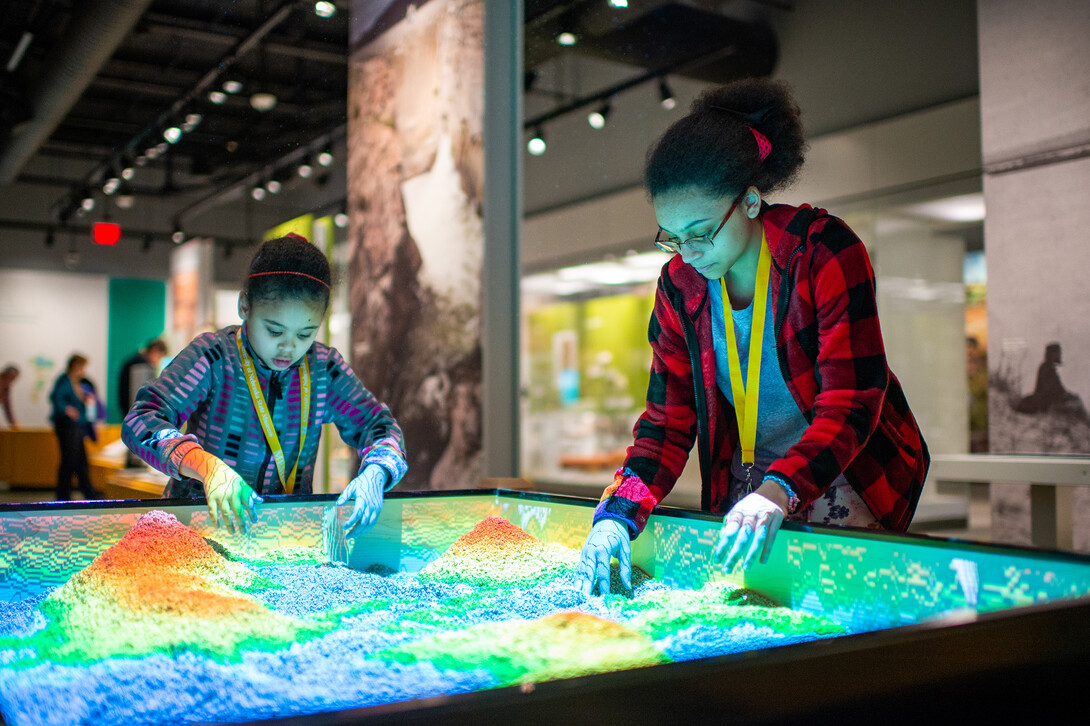
From its humble beginnings as a “Scientific Cabinet” in 1871, the University of Nebraska State Museum has continued to grow and evolve into a world-class museum that includes three sites across the state and boasts about 13 million specimens and cultural artifacts in its collections.
This year, the museum is celebrating its 150th anniversary.
The Board of Regents voted to provide monetary support for a scientific cabinet on June 14, 1871, as an asset for the fledgling university. In the beginning, the cabinet held a very small set of specimens and anthropological materials housed in the old Nebraska Hall, one of four original campus buildings.
The cabinet puttered along through its first two curators without much expansion until Edwin H. Barbour, who had just earned his doctorate from Yale University, arrived on campus in 1891 as the new director. A year later, his sister Carrie Barbour joined the university to provide instruction in the fine arts, but she was also an accomplished invertebrate paleontologist. She quickly transitioned to the museum as assistant curator.
E.H. Barbour led expeditions to collect geological, paleontological and zoological specimens to document the natural resources of Nebraska. Carrie Barbour joined her brother on many of these expeditions and was a trailblazer for women scientists, as she was one of the world’s first female paleontologists who was a paid professional in her field.
In 1892, E.H Barbour met and became friends with Regent Charles Morrill — a friendship that would become significant in the museum’s future growth. A successful businessman, Morrill was impressed with Barbour’s first finds and began providing funding for numerous expeditions. As a regent, he helped secure the state funding needed for a new museum to house and publicly display the collections.
Morrill Hall, named for Charles Morrill, opened in 1927.
By the time Barbour retired in 1941, much of the museum’s core collections were well-established. The collections had become so large that Morrill Hall could no longer house them all. Various collections were moved and maintained in Bessey Hall, Agricultural Science Hall and other locations. Most moves were made on the basis of allowing professors and students to use the specimens to facilitate research and education.
Bertrand Schultz followed Barbour as director in 1941. In 1950, he initiated plans for the Trailside Museum of Natural History at Fort Robinson, near Crawford, Nebraska. In 1955, the Army Theatre building was gifted to the museum, launching the process of converting the historic structure into a museum. Trailside Museum opened to much fanfare on July 3, 1961, and it was dedicated July 4.
A breathtaking discovery was made when two mammoth fossils were excavated in neighboring Fort Robinson State Park. The mammoths had died in combat and their fossils were discovered with their tusks entwined. “Clash of the Mammoths,” an exhibit based on this find, was opened at Trailside in 2006.
A 1971 renovation project, partially funded by the National Science Foundation, enabled the state museum to consolidate the collections into a designated campus space. Around that time, the museum also established the Parasitology Division, founded with the collection of Harold W. Manter. To this day, the parasitology collection at the state museum is one of the largest such collections, and is utilized by researchers around the globe.
Also in 1971, near Royal, Nebraska, Michael Voorhies, professor emeritus, discovered a thick layer of volcanic ash from 12 million years ago, when rhinos, horses and elephants roamed northeastern Nebraska. Further investigation revealed an intact skull and dentary of a baby rhinoceros.
Careful excavation of the fossils yielded an entire skeleton, and others as well, a phenomenon virtually unheard of. Funding from the National Geographic Society allowed Voorhies to direct a major excavation of the site in 1978 and 1979. The project unearthed dozens of complete skeletons of horses, rhinos, camels and birds, which had been buried by the ash.
Nebraska Game and Parks began working with the state museum in 1981 to develop a possible state park at the site. In June 1991, Ashfall Fossil Beds State Historical Park opened to the public. Since its opening, the park has been designated a National Natural Landmark by the U.S. Secretary of the Interior and has been visited by Bill Nye, the “Science Guy.”
The museum has won numerous awards and accolades over the years. Most recently, it was named a Smithsonian Affiliate. The 2014 designation aligns the NU State Museum in Morrill Hall with 184 museums, educational and cultural organizations. Affiliate organizations are selected for their record of scholarship, professionalism, high-quality exhibits and effective museum education programs.
Exhibits have continued to be added and changed. In 2019, the museum opened its newest and most interactive exhibit yet, Cherish Nebraska, which traces the state’s natural and cultural history over hundreds of millions of years. The exhibit takes up the entire fourth floor of Morrill Hall. The floor had to be renovated to allow for the 11,000-square-foot project, which includes a “visible lab,” where visitors can watch scientists examine plants, animals and fossils.
The latest project the museum is undertaking is the development of digitized collections. Digitized collections will open the museum even wider to the general public and allow researchers to access the collections from around the world.







